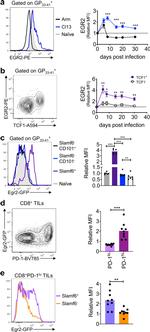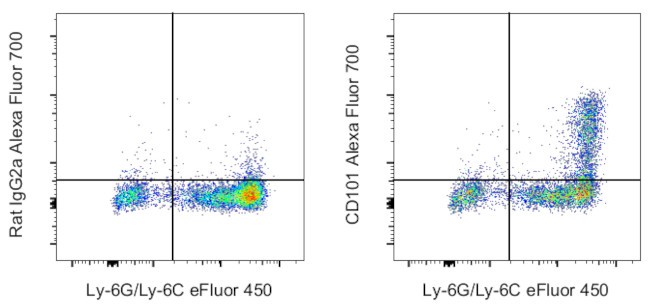Search Thermo Fisher Scientific
Invitrogen
CD101 Monoclonal Antibody (Moushi101), Alexa Fluor™ 700, eBioscience™
FIGURE: 1 / 3
CD101 Antibody (56-1011-82) in Flow



Product Details
56-1011-82
Species Reactivity
Published species
Host/Isotype
Recommended Isotype Control
Class
Type
Clone
Conjugate
Excitation/Emission Max
Form
Concentration
Purification
Storage buffer
Contains
Storage conditions
Shipping conditions
RRID
Product Specific Information
Description: The monoclonal antibody Moushi101 recognizes mouse CD101, also known as IGSF2 and V7 (7 IgV domains). CD101 is a transmembrane glycoprotein containing 7 Ig-like IgV domains and a short cytoplasmic tail with several phosphorylation sites. Cross-linking CD101 can antagonize TCR/CD3-mediated lymphocyte activation. CD101 is expressed on monocytes, granulocytes, dendritic cells, Langerhans cells and activated T cells. In addition, CD101 is found on a subset of CD25+Foxp3+ T regulatory cells that showed higher suppressive properties in vitro and in vivo.
Applications Reported: This Moushi101 antibody has been reported for use in flow cytometric analysis.
Applications Tested: This Moushi101 antibody has been tested by flow cytometric analysis of mouse bone marrow cells. This may be used at less than or equal to 0.25 µg per test. A test is defined as the amount (µg) of antibody that will stain a cell sample in a final volume of 100 µL. Cell number should be determined empirically but can range from 10^5 to 10^8 cells/test. It is recommended that the antibody be carefully titrated for optimal performance in the assay of interest.
Alexa Fluor 700 emits at 723 nm and can be excited with the red laser (633-647 nm). Most instruments will require a 685 LP mirror and 710/20 band pass filter. Please make sure that your instrument is capable of detecting this fluorochrome.
Excitation: 633-647 nm; Emission: 723 nm; Laser: Red Laser
Target Information
CD101 also known as V7 antigen, a member of the Ig superfamily. CD101 is a disulfide linked homodimer of unknown function. Expression of CD101 is found on monocytes, granulocytes and dendritic cells (Langerhan-like cells HLA-DR, CD1a, CD1c). In addition expression on T lymphocytes is important for cell activation. CD101+ CD28+ cells are very responsive to CD28 signaling. In combination with anti-CD28 or suboptimal levels of anti-CD3, anti-CD101 can increase proliferation thereby suggesting an activating role. The monoclonal antibody BB27 has been shown to inhibit the T cell reactivity in allogeneic and antigen-specific mixed DC-T cell cultures. Recently it has been demonstrated that mouse CD101 is found on a subpopulation of regulatory T cells (CD4, CD25, Foxp3 positive) that have high suppressor activity. Expression of CD101 on human PBMCs shows staining of about 30% of the Foxp3 positive cells. Studies have not confirmed higher suppressor activity in the human CD101 population.
For Research Use Only. Not for use in diagnostic procedures. Not for resale without express authorization.
How to use the Panel Builder
Watch the video to learn how to use the Invitrogen Flow Cytometry Panel Builder to build your next flow cytometry panel in 5 easy steps.
Bioinformatics
Protein Aliases: CD101; EWI immunoglobulin subfamily member EWI-101; EWI-101; Glu-Trp-Ile EWI motif-containing protein 101; IgSF2; Immunoglobulin superfamily member 2; immunoglobulin superfamily, member 2; leukocyte surface protein; RP11-27K13.2
Gene Aliases: Cd101; EWI-101; Gm1016; Gm734; Igsf2
UniProt ID: (Mouse) A8E0Y8
Entrez Gene ID: (Mouse) 630146

Performance Guarantee
If an Invitrogen™ antibody doesn't perform as described on our website or datasheet,we'll replace the product at no cost to you, or provide you with a credit for a future purchase.*
Learn more
We're here to help
Get expert recommendations for common problems or connect directly with an on staff expert for technical assistance related to applications, equipment and general product use.
Contact tech support

